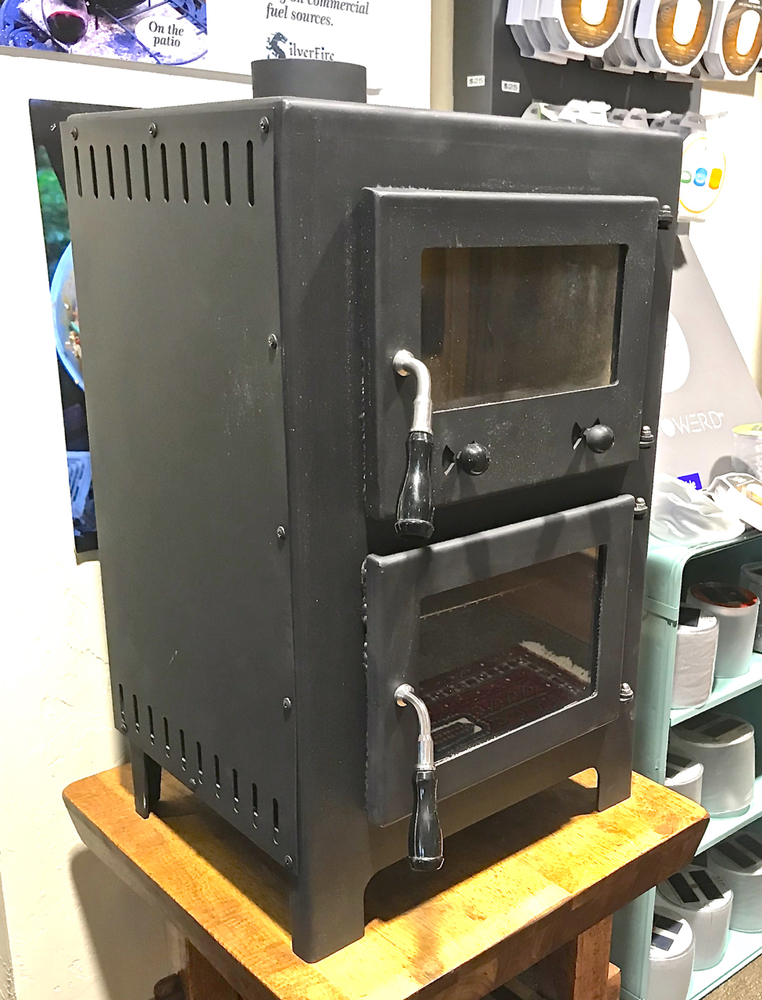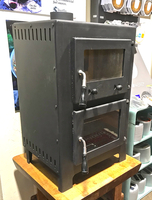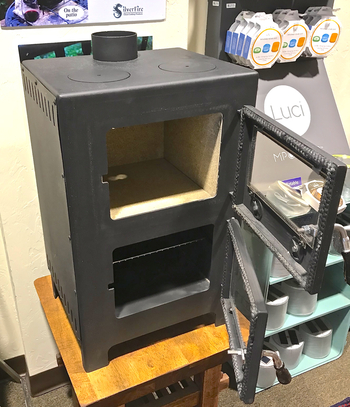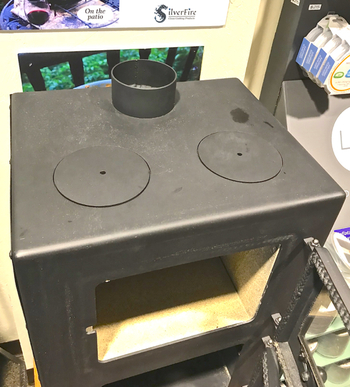The Double Burner Baking Dragon! The Double Burner Baking Dragon is a two-compartment stove designed for cooking, baking, and heating! It has a double burner cooktop and a heavy metal firebox on top (with 2 small removable cooktop plates for intense wok style cooking). Frying can be done on the cooktop with plates left in place. The oven compartment is below and you're up to 350 degrees in around 20 minutes for baking. Add more fuel for pizza or sourdough bread (500 degrees).
The chimney pipe vents vertically from off the top of the stove directly through the roof. This stove does not accommodate stove elbows and has to be vented vertically only (using 6" diameter stove pipe and requires a minimum of 15' of vertical chimney pipe). The clean secondary gasification is clean burning and exquisite! This stove can bake, cook, or radiate heat for very prolonged periods.
This small footprint stove can heat up to 1,500 square feet and excepts up to 9" long dimensional firewood. It is designed for seasoned, dry firewood. This stove has an adjustable sliding primary ventilation damper on the firebox door and steady-state secondary combustion at top of the stove internally. The stove features 2 removable cooktop inserts, both 4 & 3/4" OD.
The stove is 17" wide x 15" deep x 27" tall and includes a rear-mounted 6" diameter chimney adaptor protruding through the top rear section of the cooktop. The stove is 170 lbs. (approximately 77kg). The firebox is 11.75" wide x 11.50" deep x 10.5" tall.
This item is delivered curbside by a freight truck with liftgate only. Call or write for LTL lift gate delivery freight quote, shipping varies per location. Average discounted shipping pr
Additional photos pending. This stove must be vented vertically through the roof only, this specific stove cannot be adapted to elbows (to minimize draft resistance). This stove uses a 6" diameter chimney pipe. The sections should extend to the top of the gable or higher to ensure an adequate draft. We recommend a minimum of 15' of straight chimney pipe or more. If experiencing drafting issues, a chimney draft inducer (inline stove pipe fan unit) may be desirable to improve the draft.
Draft inducers are designed to offset air pressure from wind, cold air, and inadequate chimney height by providing negative air pressure that forces chimney air from a stove up through the chimney and into the outside air.
Important break-in instructions:
It's really important to do your first burn or two outdoors, with a chimney attached. I recommend a minimum of 15' of stove straight pipe. No elbows (increases resistance and reduces draft).
Light a small fire at the rear of the firebox (directly below the chimney) to pre-heat the chimney. The warmed chimney improves draft with the firebox door sliding damper fully open for the first 10 minutes until the fire is well established
It is normal for the stove to off-gas heat resistant stove paint and creates lots of smoke with the first burn.
Copious amounts of smoke will likely pour out the top and bottom stove side ventilation ports, as well as small streams of smoke through cooktop plate holes during the initial burn. Don't fret, this is normal.
After smoke diminishes and the fire is well established, the firebox door damper can be closed down most of the way with maybe a 1/8" gap (slightly cracked), and then you should be at a clean burn if using dry fuel.
It is important to get a feel for the operation of any stove prior to burning indoors. The oven is up to 350 degrees in about 20 minutes and easily can climb to 500 degrees using more fuel.
Tips to Prevent Soot Build Up on Wood Stove Glass:
 Thereís nothing quite like a beautiful wood stove fire during the colder seasons. Soot build-up on wood stove glass can decrease the visual appeal of a wood stove fire, and it can become rather laborious to have to constantly clean the glass every time you have a fire.
Thereís nothing quite like a beautiful wood stove fire during the colder seasons. Soot build-up on wood stove glass can decrease the visual appeal of a wood stove fire, and it can become rather laborious to have to constantly clean the glass every time you have a fire.
Here are some easy tips to prevent soot build-up on your wood stove glass. Cleaner glass will add greater ambiance to a room and allow you to enjoy more fires in your wood stove before having to clean the glass again.
Tips to Prevent Soot Build Up on Wood Stove Glass
- Always burn well-seasoned wood in your wood stove. Burning wood that hasnít been well-seasoned can decrease the quality of your fire and cause it to be ďsmoky.Ē Smokier fires produce more soot build upon the glass.
- Try burning harder woods like oak, cherry, or walnut, and avoid burning woods known for their higher sap content.
- If your wood stove has a heat setting, try turning the heat controls up a few notches. Hotter fires will keep your glass cleaner.
- Allow enough oxygen to vent into your wood stove. Many of the newer models are already built to help with the airflow. Check the chimney/vent to make sure itís clean and in a good position for airflow.
- If youíre burning smaller fires, try adding some more wood to the woodstove. Smaller fires canít always produce enough heat inside the wood stove for the soot to burn off the glass.
- Position burning matter closer to the front glass on the woodstove. This will put the heat source closer to the glass.
Enjoy Beautiful Fires from Your Wood Stove All Season Long
You canít completely prevent soot from accumulating on the glass, but these tips should help increase the time between cleanings. Soot build-up on wood stove glass is less of a problem for newer models than older models, but regardless of how old your wood stove is, you can still experience beautiful fires from your wood stove all season long.
- Description

- Always burn well-seasoned wood in your wood stove. Burning wood that hasnít been well-seasoned can decrease the quality of your fire and cause it to be ďsmoky.Ē Smokier fires produce more soot build upon the glass.
- Try burning harder woods like oak, cherry, or walnut, and avoid burning woods known for their higher sap content.
- If your wood stove has a heat setting, try turning the heat controls up a few notches. Hotter fires will keep your glass cleaner.
- Allow enough oxygen to vent into your wood stove. Many of the newer models are already built to help with the airflow. Check the chimney/vent to make sure itís clean and in a good position for airflow.
- If youíre burning smaller fires, try adding some more wood to the woodstove. Smaller fires canít always produce enough heat inside the wood stove for the soot to burn off the glass.
- Position burning matter closer to the front glass on the woodstove. This will put the heat source closer to the glass.
- Reviews

The Double Burner Baking Dragon! The Double Burner Baking Dragon is a two-compartment stove designed for cooking, baking, and heating! It has a double burner cooktop and a heavy metal firebox on top (with 2 small removable cooktop plates for intense wok style cooking). Frying can be done on the cooktop with plates left in place. The oven compartment is below and you're up to 350 degrees in around 20 minutes for baking. Add more fuel for pizza or sourdough bread (500 degrees).
The chimney pipe vents vertically from off the top of the stove directly through the roof. This stove does not accommodate stove elbows and has to be vented vertically only (using 6" diameter stove pipe and requires a minimum of 15' of vertical chimney pipe). The clean secondary gasification is clean burning and exquisite! This stove can bake, cook, or radiate heat for very prolonged periods.
This small footprint stove can heat up to 1,500 square feet and excepts up to 9" long dimensional firewood. It is designed for seasoned, dry firewood. This stove has an adjustable sliding primary ventilation damper on the firebox door and steady-state secondary combustion at top of the stove internally. The stove features 2 removable cooktop inserts, both 4 & 3/4" OD.
The stove is 17" wide x 15" deep x 27" tall and includes a rear-mounted 6" diameter chimney adaptor protruding through the top rear section of the cooktop. The stove is 170 lbs. (approximately 77kg). The firebox is 11.75" wide x 11.50" deep x 10.5" tall.
This item is delivered curbside by a freight truck with liftgate only. Call or write for LTL lift gate delivery freight quote, shipping varies per location. Average discounted shipping pr
Additional photos pending. This stove must be vented vertically through the roof only, this specific stove cannot be adapted to elbows (to minimize draft resistance). This stove uses a 6" diameter chimney pipe. The sections should extend to the top of the gable or higher to ensure an adequate draft. We recommend a minimum of 15' of straight chimney pipe or more. If experiencing drafting issues, a chimney draft inducer (inline stove pipe fan unit) may be desirable to improve the draft.
Draft inducers are designed to offset air pressure from wind, cold air, and inadequate chimney height by providing negative air pressure that forces chimney air from a stove up through the chimney and into the outside air.
Important break-in instructions:
It's really important to do your first burn or two outdoors, with a chimney attached. I recommend a minimum of 15' of stove straight pipe. No elbows (increases resistance and reduces draft).
Light a small fire at the rear of the firebox (directly below the chimney) to pre-heat the chimney. The warmed chimney improves draft with the firebox door sliding damper fully open for the first 10 minutes until the fire is well established
It is normal for the stove to off-gas heat resistant stove paint and creates lots of smoke with the first burn.
Copious amounts of smoke will likely pour out the top and bottom stove side ventilation ports, as well as small streams of smoke through cooktop plate holes during the initial burn. Don't fret, this is normal.
After smoke diminishes and the fire is well established, the firebox door damper can be closed down most of the way with maybe a 1/8" gap (slightly cracked), and then you should be at a clean burn if using dry fuel.
It is important to get a feel for the operation of any stove prior to burning indoors. The oven is up to 350 degrees in about 20 minutes and easily can climb to 500 degrees using more fuel.
Tips to Prevent Soot Build Up on Wood Stove Glass:
 Thereís nothing quite like a beautiful wood stove fire during the colder seasons. Soot build-up on wood stove glass can decrease the visual appeal of a wood stove fire, and it can become rather laborious to have to constantly clean the glass every time you have a fire.
Thereís nothing quite like a beautiful wood stove fire during the colder seasons. Soot build-up on wood stove glass can decrease the visual appeal of a wood stove fire, and it can become rather laborious to have to constantly clean the glass every time you have a fire.
Here are some easy tips to prevent soot build-up on your wood stove glass. Cleaner glass will add greater ambiance to a room and allow you to enjoy more fires in your wood stove before having to clean the glass again.
Tips to Prevent Soot Build Up on Wood Stove Glass
Enjoy Beautiful Fires from Your Wood Stove All Season Long
You canít completely prevent soot from accumulating on the glass, but these tips should help increase the time between cleanings. Soot build-up on wood stove glass is less of a problem for newer models than older models, but regardless of how old your wood stove is, you can still experience beautiful fires from your wood stove all season long.




